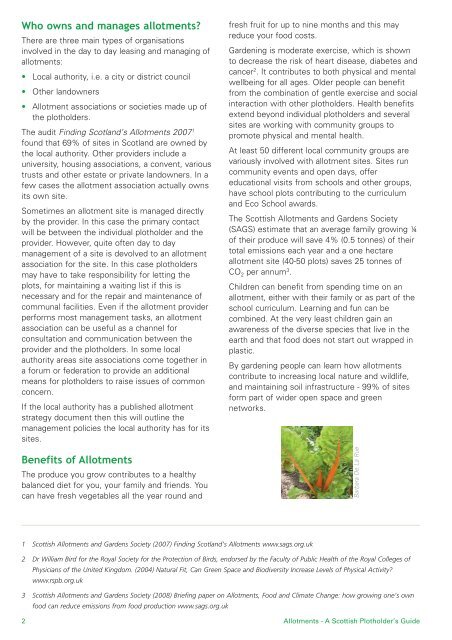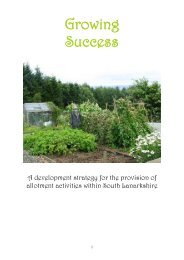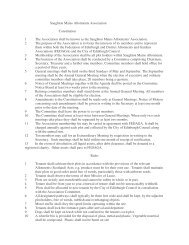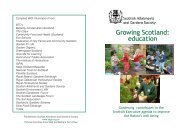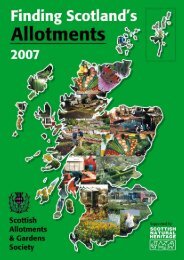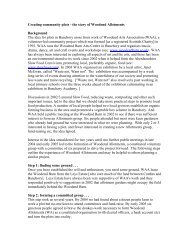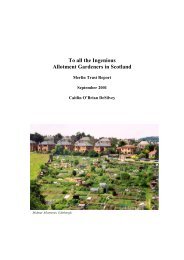Scot plot guide Q3:layout 7 - Scottish Allotments and Gardens Society
Scot plot guide Q3:layout 7 - Scottish Allotments and Gardens Society
Scot plot guide Q3:layout 7 - Scottish Allotments and Gardens Society
You also want an ePaper? Increase the reach of your titles
YUMPU automatically turns print PDFs into web optimized ePapers that Google loves.
Who owns <strong>and</strong> manages allotments?There are three main types of organisationsinvolved in the day to day leasing <strong>and</strong> managing ofallotments:• Local authority, i.e. a city or district council• Other l<strong>and</strong>owners• Allotment associations or societies made up ofthe <strong>plot</strong>holders.The audit Finding <strong>Scot</strong>l<strong>and</strong>’s <strong>Allotments</strong> 2007 1found that 69% of sites in <strong>Scot</strong>l<strong>and</strong> are owned bythe local authority. Other providers include auniversity, housing associations, a convent, varioustrusts <strong>and</strong> other estate or private l<strong>and</strong>owners. In afew cases the allotment association actually ownsits own site.Sometimes an allotment site is managed directlyby the provider. In this case the primary contactwill be between the individual <strong>plot</strong>holder <strong>and</strong> theprovider. However, quite often day to daymanagement of a site is devolved to an allotmentassociation for the site. In this case <strong>plot</strong>holdersmay have to take responsibility for letting the<strong>plot</strong>s, for maintaining a waiting list if this isnecessary <strong>and</strong> for the repair <strong>and</strong> maintenance ofcommunal facilities. Even if the allotment providerperforms most management tasks, an allotmentassociation can be useful as a channel forconsultation <strong>and</strong> communication between theprovider <strong>and</strong> the <strong>plot</strong>holders. In some localauthority areas site associations come together ina forum or federation to provide an additionalmeans for <strong>plot</strong>holders to raise issues of commonconcern.If the local authority has a published allotmentstrategy document then this will outline themanagement policies the local authority has for itssites.Benefits of <strong>Allotments</strong>The produce you grow contributes to a healthybalanced diet for you, your family <strong>and</strong> friends. Youcan have fresh vegetables all the year round <strong>and</strong>fresh fruit for up to nine months <strong>and</strong> this mayreduce your food costs.Gardening is moderate exercise, which is shownto decrease the risk of heart disease, diabetes <strong>and</strong>cancer 2 . It contributes to both physical <strong>and</strong> mentalwellbeing for all ages. Older people can benefitfrom the combination of gentle exercise <strong>and</strong> socialinteraction with other <strong>plot</strong>holders. Health benefitsextend beyond individual <strong>plot</strong>holders <strong>and</strong> severalsites are working with community groups topromote physical <strong>and</strong> mental health.At least 50 different local community groups arevariously involved with allotment sites. Sites runcommunity events <strong>and</strong> open days, offereducational visits from schools <strong>and</strong> other groups,have school <strong>plot</strong>s contributing to the curriculum<strong>and</strong> Eco School awards.The <strong>Scot</strong>tish <strong>Allotments</strong> <strong>and</strong> <strong>Gardens</strong> <strong>Society</strong>(SAGS) estimate that an average family growing ¼of their produce will save 4% (0.5 tonnes) of theirtotal emissions each year <strong>and</strong> a one hectareallotment site (40-50 <strong>plot</strong>s) saves 25 tonnes ofCO 2 per annum 3 .Children can benefit from spending time on anallotment, either with their family or as part of theschool curriculum. Learning <strong>and</strong> fun can becombined. At the very least children gain anawareness of the diverse species that live in theearth <strong>and</strong> that food does not start out wrapped inplastic.By gardening people can learn how allotmentscontribute to increasing local nature <strong>and</strong> wildlife,<strong>and</strong> maintaining soil infrastructure - 99% of sitesform part of wider open space <strong>and</strong> greennetworks.Barbara De La Rue1 <strong>Scot</strong>tish <strong>Allotments</strong> <strong>and</strong> <strong>Gardens</strong> <strong>Society</strong> (2007) Finding <strong>Scot</strong>l<strong>and</strong>’s <strong>Allotments</strong> www.sags.org.uk2 Dr William Bird for the Royal <strong>Society</strong> for the Protection of Birds, endorsed by the Faculty of Public Health of the Royal Colleges ofPhysicians of the United Kingdom. (2004) Natural Fit, Can Green Space <strong>and</strong> Biodiversity Increase Levels of Physical Activity?www.rspb.org.uk3 <strong>Scot</strong>tish <strong>Allotments</strong> <strong>and</strong> <strong>Gardens</strong> <strong>Society</strong> (2008) Briefing paper on <strong>Allotments</strong>, Food <strong>and</strong> Climate Change: how growing one’s ownfood can reduce emissions from food production www.sags.org.uk2 <strong>Allotments</strong> - A <strong>Scot</strong>tish Plotholder’s Guide


